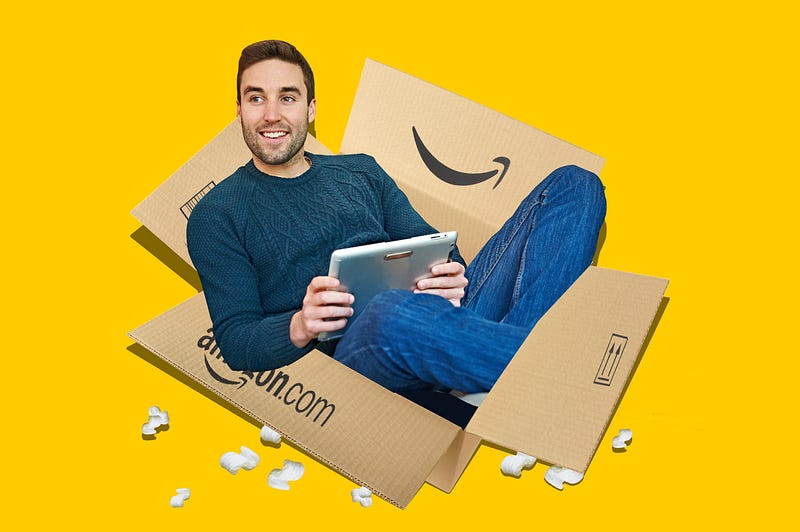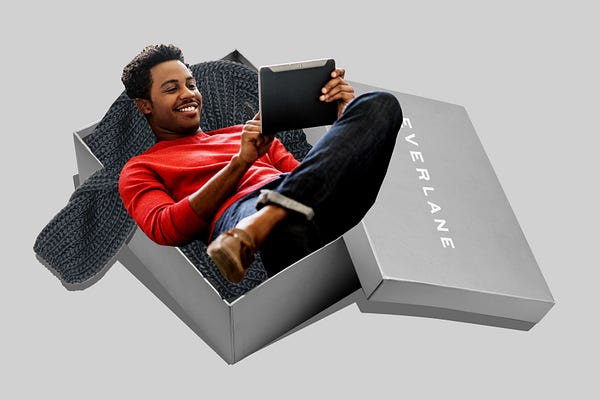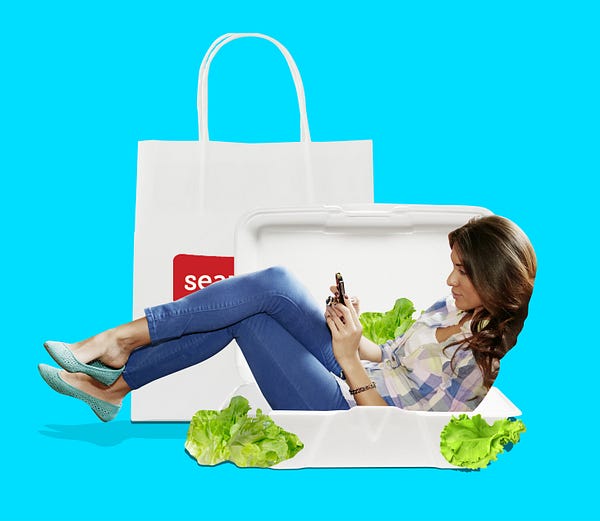The Shut-In Economy — Matter — Medium
The Shut-In Economy

In the new world of on-demand everything, you’re either pampered, isolated royalty — or you’re a 21st century servant.
By Lauren Smiley

Angel the concierge stands behind a lobby desk at a luxe apartment building in downtown San Francisco, and describes the residents of this imperial, 37-story tower. “Ubers, Squares, a few Twitters,” she says. “A lot of work-from-homers.”
And by late afternoon on a Tuesday, they’re striding into the lobby at a just-get-me-home-goddammit clip, some with laptop bags slung over their shoulders, others carrying swank leather satchels. At the same time a second, temporary population streams into the building: the app-based meal delivery people hoisting thermal carrier bags and sacks. Green means Sprig. A huge M means Munchery. Down in the basement, Amazon Prime delivery people check in packages with the porter. The Instacart groceries are plunked straight into a walk-in fridge.
This is a familiar scene. Five months ago I moved into a spartan apartment a few blocks away, where dozens of startups and thousands of tech workers live. Outside my building there’s always a phalanx of befuddled delivery guys who seem relieved when you walk out, so they can get in. Inside, the place is stuffed with the goodies they bring: Amazon Prime boxes sitting outside doors, evidence of the tangible, quotidian needs that are being serviced by the web. The humans who live there, though, I mostly never see. And even when I do, there seems to be a tacit agreement among residents to not talk to one another. I floated a few “hi’s” in the elevator when I first moved in, but in return I got the monosyllabic, no-eye-contact mumble. It was clear: Lady, this is not that kind of building.
Back in the elevator in the 37-story tower, the messengers do talk, one tells me. They end up asking each other which apps they work for: Postmates. Seamless. EAT24. GrubHub. Safeway.com. A woman hauling two Whole Foods sacks reads the concierge an apartment number off her smartphone, along with the resident’s directions: “Please deliver to my door.”
“They have a nice kitchen up there,” Angel says. The apartments rent for as much as $5,000 a month for a one-bedroom. “But so much, so much food comes in. Between 4 and 8 o’clock, they’re on fire.”
I start to walk toward home. En route, I pass an EAT24 ad on a bus stop shelter, and a little further down the street, a Dungeons & Dragons–type dude opens the locked lobby door of yet another glass-box residential building for a Sprig deliveryman:
“You’re…”
“Jonathan?”
“Sweet,” Dungeons & Dragons says, grabbing the bag of food. The door clanks behind him.
And that’s when I realized: the on-demand world isn’t about sharing at all. It’s about being served. This is an economy of shut-ins.


In 1998, Carnegie Mellon researchers warned that the internet could make us into hermits. They released a study monitoring the social behavior of 169 people making their first forays online. The web-surfers started talking less with family and friends, and grew more isolated and depressed. “We were surprised to find that what is a social technology has such anti-social consequences,” said one of the researchers at the time. “And these are the same people who, when asked, describe the Internet as a positive thing.”
We’re now deep into the bombastic buildout of the on-demand economy— with investment in the apps, platforms and services surging exponentially. Right now Americans buy nearly eight percent of all their retail goods online, though that seems a wild underestimate in the most congested, wired, time-strapped urban centers.

Many services promote themselves as life-expanding — there to free up your time so you can spend it connecting with the people you care about, not standing at the post office with strangers. Rinse’s ad shows a couple chilling at a park, their laundry being washed by someone, somewhere beyond the picture’s frame. But plenty of the delivery companies are brutally honest that, actually, they never want you to leave home at all.
GrubHub’s advertising banks on us secretly never wanting to talk to a human again: “Everything great about eating, combined with everything great about not talking to people.” DoorDash, another food delivery service, goes for the all-caps, batshit extreme:
“NEVER LEAVE HOME AGAIN.”
Katherine van Ekert isn’t a shut-in, exactly, but there are only two things she ever has to run errands for any more: trash bags and saline solution. For those, she must leave her San Francisco apartment and walk two blocks to the drug store, “so woe is my life,” she tells me. (She realizes her dry humor about #firstworldproblems may not translate, and clarifies later: “Honestly, this is all tongue in cheek. We’re not spoiled brats.”) Everything else is done by app. Her husband’s office contracts with Washio. Groceries come from Instacart. “I live on Amazon,” she says, buying everything from curry leaves to a jogging suit for her dog, complete with hoodie.
She’s so partial to these services, in fact, that she’s running one of her own: A veterinarian by trade, she’s a co-founder of VetPronto, which sends an on-call vet to your house. It’s one of a half-dozen on-demand services in the current batch at Y Combinator, the startup factory, including a marijuana delivery app called Meadow (“You laugh, but they’re going to be rich,” she says). She took a look at her current clients — they skew late 20s to late 30s, and work in high-paying jobs: “The kinds of people who use a lot of on demand services and hang out on Yelp a lot ☺”
Basically, people a lot like herself. That’s the common wisdom: the apps are created by the urban young for the needs of urban young. The potential of delivery with a swipe of the finger is exciting for van Ekert, who grew up without such services in Sydney and recently arrived in wired San Francisco. “I’m just milking this city for all it’s worth,” she says. “I was talking to my father on Skype the other day. He asked, ‘Don’t you miss a casual stroll to the shop?’ Everything we do now is time-limited, and you do everything with intention. There’s not time to stroll anywhere.”
Suddenly, for people like van Ekert, the end of chores is here. After hours, you’re free from dirty laundry and dishes. (TaskRabbit’s ad rolls by me on a bus: “Buy yourself time — literally.”)
So here’s the big question. What does she, or you, or any of us do with all this time we’re buying? Binge on Netflix shows? Go for a run? Van Ekert’s answer: “It’s more to dedicate more time to working.”


Alfred, maybe, is the inevitable end point of this system. It’s an on-demand assistant that coordinates all the other on-demand apps for you, and it’s aimed at two groups: people who want the benefits of various apps but don’t want to bother setting them all up, and the “air traffic controllers,” who already have so many services coming to relieve their burden that coordinating them has become a new burden all of its own.
With Alfred, you no longer have to open the door for the Instacart delivery: A worker comes into your apartment and stocks food in your fridge. You don’t hand off your dirty undies to a Washio messenger; Alfred puts the laundered undies in the drawer. This all happens by paying your Alfred $99 a month, plus the goods and services at reduced cost through Alfred’s hookups. Alfred won first place in the TechCrunch Disrupt SF conference last year.

Shutting people out is an important part of being a shut-in: When signing up, customers can choose the option of not seeing their Alfred, who will come in when they’re at work. Alfred’s messaging is aimed at sweeping aside any middle-class shame.
“We’re trying to remove the taboo and the guilt that you should have to do it,” says Alfred’s CEO Marcela Sapone over the phone. “We’re empowering you to let others do it for you. You’re the manager of your life. It’s against the stigma of ‘People use this because they’re lazy.’ Absolutely not. They’re using this because they’re extremely busy.”
She’s talking about people like Christina Mallon, whom the Alfred folks put me in contact with. Mallon is a 26-year-old in New York City who works as a branding sales consultant to tech companies, regularly working from 8 a.m. to 9 p.m. Unlike the Silicon Valley tech campuses she works with, Mallon has no worksite cafeteria, so she uses food delivery apps for lunch and dinner. Her old West Village building has limited hot water, she says, so she gets her hair blown out three days a week using Vive, a subscription hairdresser service, for $100 a month.
When Mallon gets back to her apartment at night for about a precious hour of free time before heading to bed (her boyfriend, who works in private equity, doesn’t make it home until 1 a.m.) Alfred has handled the rest. Gluten-free groceries from Whole Foods in the cupboards, her laundry hung, her packages picked up, others delivered, her bed made, her kitchen table tidied — and a note asking what she needs for next time.
But the three hours she estimates Alfred saves her each week also buys her time to get out —she no longer has to wait at home on Saturdays waiting for TaskRabbits or FreshDirect groceries to appear.
“My mom and dad worked a lot, so we grew up on fast food and had a cleaner come once every two weeks,” Mallon says. “I had to do my bed every morning and everything had to be clean. No allowance. I have a strong work ethic and worked 24–7 in college and went to school at night, so I know how to get things done. You have to outsource things that someone else can do for cheaper. To save an hour a day, I would spend $25.”
In one hour of chore time saved, Mallon estimates she can make $1,000 for her company. Tech companies have long realized that if you hook up your employees with everything on site, they’ll work longer, more industrious hours. And if apps deliver that same to the home, corporations keep benefiting. Employees can work even more undistracted hours remotely or buy even more on-demand services (like that Netflix binge). The perfect cycle of productivity and consumption is created— and all without ever having to step outside.


In many ways, social class can be defined by the chores you don’t do. The rich have personal assistants, butlers, cooks, drivers. The middle class largely do their own errands — with the occasional babysitter, pizza boy, maybe a cleaner. The poor do their own chores, and the chores of other people.
Then came on-demand’s disruptive influence. The luxuries usually afforded to one-percenters now stretch to the urban upper-middle class, or so the technology industry cheers. But can you democratize the province of the rich without getting a new class acting, well, entitled? My parents made me put away the dishes not to “outsource” their workload — they could have done it faster. They did it so I wouldn’t turn out to be a brat.
Now an entire generation is not just being served: It’s having to work out what it means when you buy someone to do it for you.
Katy Rogers is a 29-year-old account director at a social startup, and a regular with laundry and grocery apps. But when the Homejoy app maid shows up at her apartment, she feels uncomfortable. The class implications of someone cleaning her toilet are jarring. “I feel like it’s a little bit awkward. I’m thinking, what do these people think of me?” She also wonders about the workers. Rogers wishes the companies were a bit more transparent about the payment structure. (“Some of them say there’s no need to tip. I’m like why? How much are they actually going to earn?”)
While Dungeon & Dragons grabbed his dinner eagerly, Rogers has found herself tinkering with how exactly to interact with her hired help. By the end of our chat, it seemed as if she had almost talked herself out of the whole enterprise.“Maybe that’s something I should just do myself.”
Who cleaned her house growing up? I ask.
“My mom did everything.”
That’s the other side of this, the gender one. The errands being served up by the on-demand economy — cooking, cleaning, laundry, groceries, runs to the post office — all were all once, and in many places still are, the jobs of stay-at-home mothers. Even now, when women outnumber men in the formal workplace, they continue to bear the brunt of that invisible domestic work, often for many, many hours a week. So women — those who can afford it, at least — have the most to win from passing that load on to somebody else.
So it’s not a surprise that 60 percent of Alfred’s clients are female. One mother I know told me she has no time to cook while wrangling two kids under two, so she uses EAT24. Uber is an easy way to get out of the house with an infant, another told me, saying the driver helped her strap the baby seat into the black sedan.
The invisible work handed off by some women simply becomes visible — oftentimes for other, less wealthy women. Despite the name, 75 percent of “Alfreds” are women.


Last year the venture capital firm SherpaVentures — whose offices are just down the street from that apartment building full of Ubers and Squares and Twitters— released a sunny study on the future of our on-demand world. They have a stake in making it go big , of course: they’re seed investors in Shyp and Munchery and have $154 million to invest in on-demand businesses. As the desire for more instant, app-based services expands up the economic chain, the report argued, entrepreneurial freelancers — everyone from grocery deliverers to cleaners to accountants to lawyers — will have flexibility to monetize their time when they want to and pursue their passions. Brick-and-mortar stores die out, and so do their low-wage retail jobs, which it suggested would personalize the world, away from the sterile anonymity of big-box stores to a “21st-century village economy,” in which we’re “united” by cellphones.
So who are we uniting with in this scenario?
Some workers in the on-demand economy are hourly employees with benefits. Many others prefer an army of free-roving freelancers. Uber released a study purporting that the drivers (or “partners”) are happy with this: more than 70 percent of its drivers preferred setting their own hours over a traditional job. Other drivers dissent on this point, filing lawsuits.
In the stream of delivery workers coming into the 37-story apartment fortress next to Uber HQ was TaNica, a Sprig contractor. She had been out of the work force for three years when she started with the app. “This is a job I need, but I actually love,” she says. She likes driving around — she works every day and tries to get in 50 hours a week, at $16 an hour. Not all the workers were so happy, though. The Google Express contractor in my lobby told me she’d earned a college degree in criminology and hopes to find a job in her field. Another bicycle messenger showed me in his phone’s settings how the app could track him at all hours, which he found Orwellian. He talked for a few minutes about how he’s just doing this part-time between creative gigs, and hoped to get out soon. Before we finished talking, his app flashed a message: “Let’s move!” and he pushed off.


The SherpaVentures report didn’t mention shut-ins. It did, however, point out that grocery delivery has taken off massively in hyper-dense developing countries, where huge income disparities allow upper-middle-class citizens to turn the rest of the workforce into their personal delivery network. In Mexico City, the study noted, 20 percent of grocery orders are made remotely.
As income inequality increases, the shut-in model is tailor-made for the new polarized extremes.
After all, either you’re behind the door, receiving your dinner in the tower. Or you’re like the food delivery guy who, while checking in with the concierge, said, “This is my dream place to live.” He’s the opposite of a shut-in. He’s stuck outside, hustling.
Log in to Medium and “recommend” this story.
Image sources, from top: s-cphoto/Getty; Cultura RM/Getty; Dean Northcott/Getty; Zoonar/Getty; Tetra Images/Getty; Peathegee Inc/Getty.
